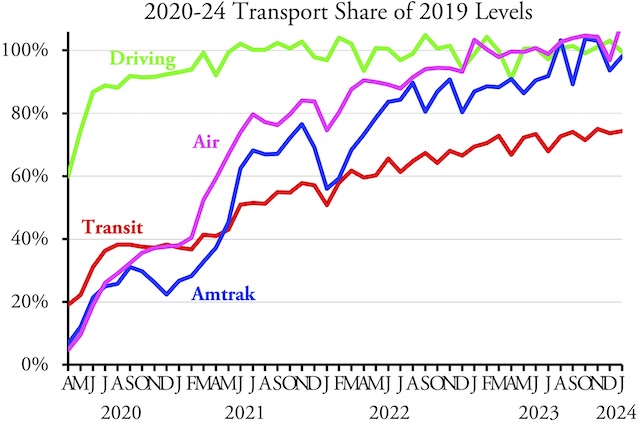In January 2024, Americans drove 99.5 percent as many miles as they did in the same month of 2019, according to data released yesterday by the Federal Highway Administration. This compares with 103.1 percent in December.
See this post for a discussion of Amtrak and air travel and this post for a review of transit data for January 2024.
January had the same number of business days in 2024 as in 2019, so that doesn’t account for the drop below 100 percent. Instead, this drop is more likely due to the mid-January snowstorm that blanketed much of the United States.
Exactly half the states saw more driving in January 2024 than 2019 while half plus DC saw less. The biggest increases in driving were in Rhode Island (32.7%), Louisiana (19.4%), Idaho (19.2%), Mississippi (13.5%), South Dakota (13.0%), Utah (11.1%), and Arizona (10.5%). The biggest shortfalls were in DC (-26.0%), West Virginia (-22.3%), Michigan (-16.4%), Arkansas (-12.4%), Kentucky (-11.7%), Massachusetts (-11.3%), Oregon (-11.0%), and North Dakota (-10.3%). These differences are largely driven by shifts in population, which may also be responsible for the fact that rural driving in 2024 was 6.0 percent greater while urban driving was 3.1 percent less than in 2019.
Whether it’s 99.5 percent or 103.1 percent of 2019, driving has clearly recovered from the pandemic. Transit has not and that’s largely because so many people are working from home and such remote working had impacted transit more than driving. This is true for two reasons: first, a high percentage of pre-pandemic transit riders were downtown office workers and these are the most likely people to have shifted to working from home. Second, many transit riders before the pandemic were using transit to avoid congestion, but increased telecommuting has reduced congestion allowing more people who don’t work at home to drive to work.
The latest data on remote working indicates that, on any given day in January, about 29 percent of people were working from home. These data were collected using an on-line survey and the researchers who collected them admit that the survey may undercount people who only have high school diplomas or are otherwise less tech-savvy.
Whether the exact number is 29 percent or a little less, what remains significant is that the share working from home in monthly surveys has hovered around 29 percent since at least August of 2022, suggesting that it is not going to change significantly in the future. This in turn means that transit ridership isn’t going to change significantly either.









Some transit services have nearly recovered.
It is metros like the Bay Area that have not done too well mainly due to high costs, higher rates impacting companies, homelessness, lawlessness, high taxes, and remote work.
Driving is down from 2019, but it’s not all bad news – at least road deaths are up!
2019: 36,355 dead
2022: 42,795 dead
https://en.wikipedia.org/wiki/Motor_vehicle_fatality_rate_in_U.S._by_year